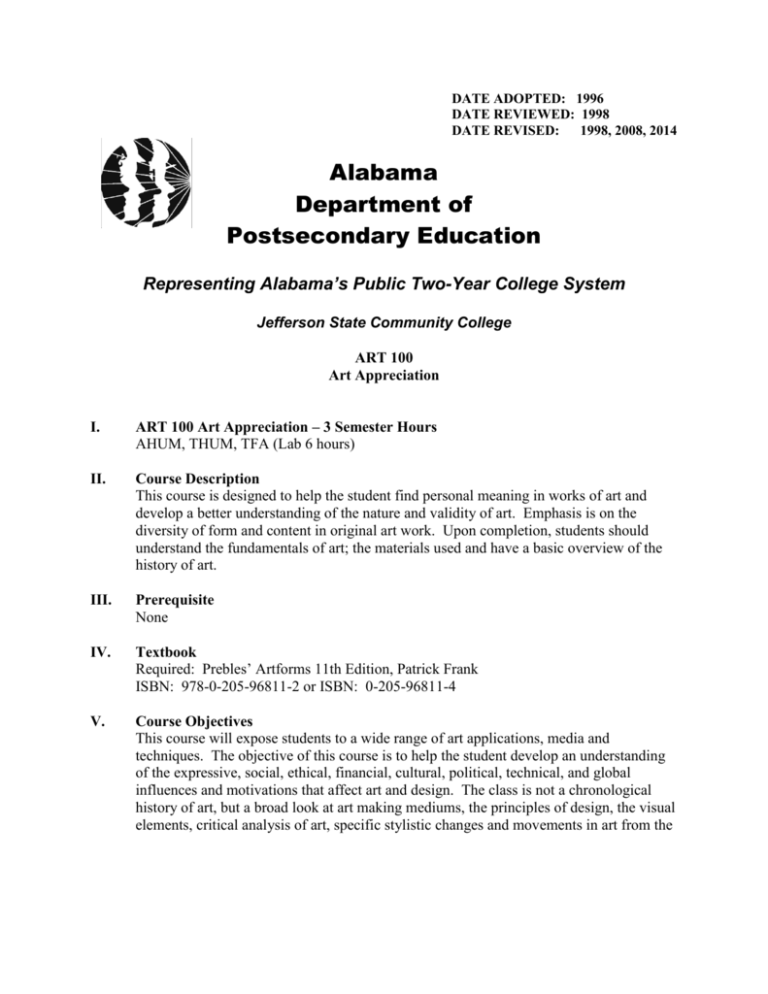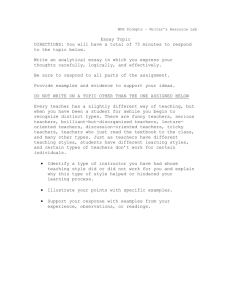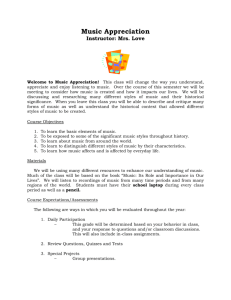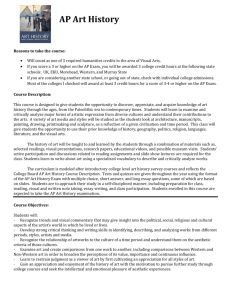ART 100 - Jefferson State Community College
advertisement

DATE ADOPTED: 1996 DATE REVIEWED: 1998 DATE REVISED: 1998, 2008, 2014 Alabama Department of Postsecondary Education Representing Alabama’s Public Two-Year College System Jefferson State Community College ART 100 Art Appreciation I. ART 100 Art Appreciation – 3 Semester Hours AHUM, THUM, TFA (Lab 6 hours) II. Course Description This course is designed to help the student find personal meaning in works of art and develop a better understanding of the nature and validity of art. Emphasis is on the diversity of form and content in original art work. Upon completion, students should understand the fundamentals of art; the materials used and have a basic overview of the history of art. III. Prerequisite None IV. Textbook Required: Prebles’ Artforms 11th Edition, Patrick Frank ISBN: 978-0-205-96811-2 or ISBN: 0-205-96811-4 V. Course Objectives This course will expose students to a wide range of art applications, media and techniques. The objective of this course is to help the student develop an understanding of the expressive, social, ethical, financial, cultural, political, technical, and global influences and motivations that affect art and design. The class is not a chronological history of art, but a broad look at art making mediums, the principles of design, the visual elements, critical analysis of art, specific stylistic changes and movements in art from the 1300’s to the present, and the universal motivators for artistic expression. Students will learn the impact of social, political, and economic changes on the arts, as well as its past and present purposes. VI. Course Outline of Topics a. Evaluating Art: Theory, Criticism, Analysis, Formal vs. Contextual, Defining Styles b. The Nature of Art and Creativity: Motivators for Art making, low, high and functional art applications c. Visual Communication: The visual Elements-building blocks of all art d. How an Artwork is Built: The Principles of Design e. Drawing: Dry and Wet Media, Alternative Approaches f. Painting: Fresco, Encaustic, Oil, Watercolor, Gouache, Acrylic, airbrush g. Printmaking: Relief, Intaglio, Lithography, Stencil, Alternative Approaches h. Photography: Pictorialism, Photo Journalism, F-64, Digital applications i. Graphic Design: Logo Design, Typography, Poster Design, Product Design j. Sculpture: Additive vs. Subtractive Sculpture, Relief Sculpture, Kinetic Sculpture, installation, Casting, Mixed Media, performance art k. Flirting with Function: Clay, Glass, Metal, Wood, Fiber, Craft traditions l. Architecture: Styles, Materials, Methods, Designing with Nature m. Brief overview of Chronological Art History: from the Paleolithic Period through the late 20th century and Postmodernism* VII. Evaluation and Assessment Tests will consist of Multiple Choice, Matching, Slide Identification and two short essays analyzing and describing specific art from each chapter test. The students will also complete two visits independently to a Fine Art Gallery, Fine Art Festival, or Fine Art Museum during the course of the semester and submit two 2-page typed essays containing a description of their experience and a critique analysis of 1-2 pieces from the collection of their choosing. Grades will be given based upon A = 90 – 100%, B = 80 – 89%, C = 70 – 79%, D = 60 – 69%, and F = below 60%. VIII. General Course Competencies a. The Student will acquire a knowledge of specific vocabulary terms and concepts unique to the discipline of art b. The Student will familiarize themselves with a variety of significant art styles and movements spanning from the Paleolithic to the late 20th century styles c. The Student will learn to write about art, using art terms, and form succinct opinions about the art they are looking at both formally and contextually d. The Student will locate and personally experience local art at any of a long list of suggested art galleries, festivals, and museums IX. Assessment of Instructional Effectiveness This section describes how student performance related to specific course objective is used to assess instructional effectiveness in helping students meet Jefferson State’s General Education Objectives. This section does not describe how course grades are determined. a. b. c. d. The student will be able to Identify the style or medium based category that a work of art might fit in based on visual clues The student will use art terms to critically analyze art in a short essay to describe the intentions and motivations of artists from different time periods The student will recognize the use and influence of fine art on popular culture and advertising The student will understand the cultural significance of art and visual expression on the development of our modern society General Education Objective The student will be able to critically analyze two works of art based on both formal and contextual criteria. This will be accomplished in two short essays on the final exam. The essays should be largely opinion based, persuasive, and make strong arguments outlining the pros and cons of the visual choices made by the artists. The essay should include several relevant art terms and vocabulary. Upon completion of the course the students should appreciate what art is and what art does in a way that compels them to personally make an effort to seek out opportunities to experience fine art beyond the class. The students, ideally, will each form a life habit of attending art museums, art festivals, and collecting, or even making, unique works of art that enrich their life. Use of Findings The instructor will review the student’s written assignments, and will average the class success on the vocabulary tests and style identification. If specific words or styles of art stand out as being misunderstood by a large percentage of the class, the instructor will alter and expand on the presentation on those terms or styles. If the content of the written assignments stands out as unusual or problematic, the instructor will review results and discuss findings with other art appreciation instructors to maintain professional objectivity toward the essay assignments X. Attendance Students are expected to attend all classes for which they are registered. Students who are unable to attend class regularly, regardless of the reason or circumstance, should withdraw from that class before poor attendance interferes with the student’s ability to achieve the objectives required in the course. Withdrawal from class can affect eligibility for federal financial aid. XI. Statement on Discrimination/Harassment The College and the Alabama State Board of Education are committed to providing both employment and educational environments free of harassment or discrimination related to an individual’s race, color, gender, religion, national origin, age, or disability. Such harassment is a violation of State Board of Education policy. Any practice or behavior that constitutes harassment or discrimination will not be tolerated. XII. Americans with Disabilities The Rehabilitation Act of 1973 (Section 504) and the Americans with Disabilities Act of 1990 state that qualified students with disabilities who meet the essential functions and academic requirements are entitled to reasonable accommodations. It is the student’s responsibility to provide appropriate disability documentation to the College. The ADA Accommodations office is located in FSC 300 (205-856-7731).






